By Donald H. Harrison
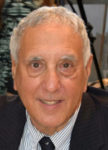
SAN DIEGO – Tifereth Israel Synagogue celebrated Yom Ha’atzma’ut, Israeli independence day, on Thursday night, May 9, with songs, four American perspectives on Israel, and the kind of dairy dinner you might be served in Tel Aviv.
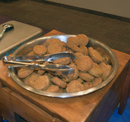
Oscar and Olga Worm own Bekker’s Catering, which typically serves non-kosher food. But the husband and wife, joined by other congregants, moved into Tifereth Israel’s kosher kitchen for the occasion and whipped up a dinner of various salads, pita, hummus, baba ghanoush, bourekas, and falafel, accompanied by a freshly squeezed combination of pomegranate and orange juice. For dessert there was Middle Eastern coffee, accompanied by baklava and other pastries.
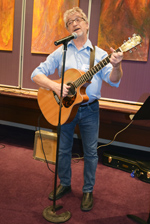
Ted Stern, a congregant who plays violin in the Shepherd Canyon band and bass guitar in Tifereth Israel’s own Shir Hadash band, taught attendees the call-and-response song Kahol v’ Laban (Blue and White), which refers to the colors of Israel’s flag and typically is sung on Yom Ha’atzma’ut. He also led the singing of Hatikvah (The Hope), the Israeli national anthem, as well as the popular Yerushalayim Shel Zahav (Jerusalem of Gold).
HaMotzi and the Shehechiyanu blessings were led by Norm Katz, president of the Tifereth Israel Men’s Club, which co-sponsored the festive evening along with the Sisterhood, led by Judy Stern. Many Men’s Club members wore their red shirts for the occasion, while some other celebrants dressed in blue and white.
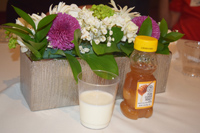
Olga Worm, who presided over the ceremonies, noted that each table was set with a jar of honey and a glass of milk, symbolic of God’s promise, mentioned in many passages throughout the Bible, to bring the Israelites out of bondage and into a land of “milk and honey.”
Following the dinner, four members of the Conservative congregation briefly shared their observations about Israel.
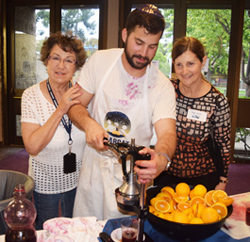
Daniel Berger, 25, who returned recently from a Birthright Israel trip, confided that at one point in his life he felt detached from Judaism. “I lost interest and stopped gong to synagogue,” he said. Visiting Israel in the company of Americans of his own age, along with Israeli peers, “built a sense of pride for the religion that I had lost. … It gave me a sense of belonging.” He also said that he was pleased to learn that Israel is on the cutting edge of technology, and that one of its inventions is the electronics package that helps cars stay in their own lanes and slow down in the event of an obstacle up ahead. Further, he said, he found Israel to be very safe. He recalled walking around at night alone, taking buses and trains, and finding that wherever he went people were friendly.
Maya Kaufmann, 16, just returned from two months at the Alexander Muss High School in Hod HaSharon, where she participated in an intensive study of Jewish history, and also took tours of the country. She was charmed by Rosh Hanikra on the Lebanese border, “with views that made me stop in my tracks” and “grottoes with shimmering bright blue water.” She enjoyed sharing dinner in a Bedouin tent, where she and classmates were seated on the ground. The daughter of an Israeli-born father, she said she found that Israelis are “direct, blunt, honest, and I love it.” She said that the land of milk and honey is one “that forever gives, and now it is our turn to give back.”
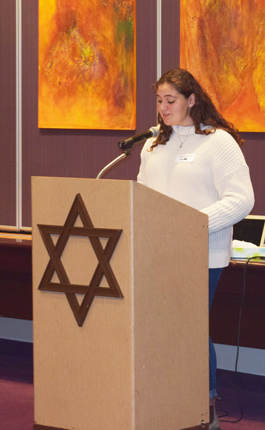
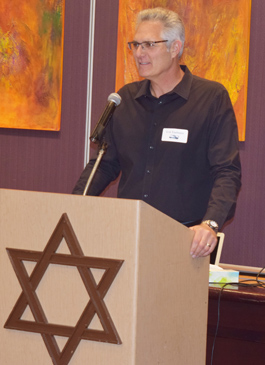
She was followed by her father, Eric Kaufmann, an executive coach, who was 15 when his family moved from Israel to the United States. Kaufmann reflected on the differences between growing up Jewish in Israel, and growing up Jewish in the United States. “Judaism in Israel is in the water,” he said. “It is in the school. It is in the TV. It is in the movies. It is in the government. It is in the food.”
He added that in Israel Jews do not think of themselves as Orthodox or Conservative. For that matter, , he “I didn’t think of myself as Jewish; I thought of myself as Israeli, but Israeli was inherently Jewish,” he said. Unlike children in the Diaspora, “I didn’t have to learn Hebrew for my bar mitzvah” as he already spoke the language.
Life was much different for his own children, he said. Not only did they have to go to Wednesday and Sunday school to learn the Hebrew language and about the Jewish religion, they had to withstand pressure all around them to conform to Christian norms. Additionally, he said, they have been growing up in a period that has seen the reemergence of anti-Semitism – as was so brutally demonstrated on April 27 with the shooting at the Chabad of Poway. Kaufmann suggested that with the Holocaust having receded nearly 75 years into the past, so too have the “shame and guilt” of the Holocaust faded among non-Jews. Many school children today don’t even know what the Holocaust was, or think of it as “fuddy duddy old history,” he said. In years past, said Kaufmann, one could walk from the parking lot directly into Tifereth Israel Synagogue. Now one must pass through a locked fence under the watchful eye of a heavily-armed guard. Judaism in America, he added, has received a gift of revitalization from Israel.
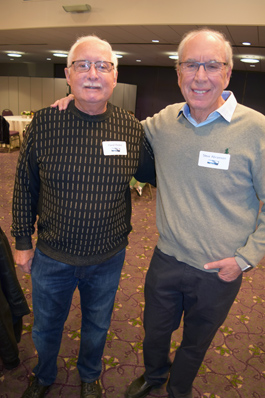
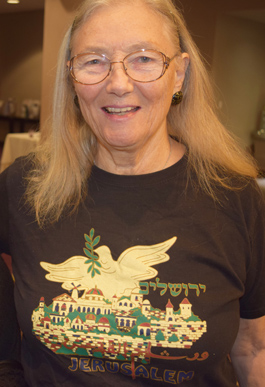
The final speaker was Steve Abramson, the retired chief executive officer of the Jewish Federation of San Diego, which was known during his reign as the United Jewish Federation. Abramson told of the time in the late 1980s when a partnership was formed between San Diego’s UJF and Sha’ar Hanegev, a municipality of ten kibbutzim and a moshav surrounding the city of Sderot on the Gaza border.
Prior to that time San Diego’s UJF had been contributing money for projects in Kiryat Malachi, a city in the southern portion of Israel. San Diego had very little input into the nature of the projects, and few interactions with the people of Kiryat Malachi. Abramson said that relationship was “very patronizing, let’s go help them, and we’ll feel nice.” It was paternalistic, a model stuck in the 1960s, Abramson said. What UJF leadership wanted was to create a real person-to-person, institution-to-institution bond between a partnership region and the local Federation. So, a committee including Richard Katz, Rod Stone, Gary Jacobs, and Shearn Platt was created to scout out Israeli cities that might be interested in a reciprocal relationship, in which both sides would plan projects together in Israel and in the United States.
Four cities were tentatively selected, and the leadership decided to use a helicopter in Israel to visit one after the other, spending a day at each. But after the second day, the group fell in love with Sha’ar Hanegev, which was “pristine, beautiful” and had a mayor, Shai Hermesh, who was “a terrific, charismatic, wonderful guy.” The San Diegans met with Sha’ar Hanegev’s regional council, and thereafter invited Hermesh to visit Federation and the various agencies in San Diego. As a result, numerous interactions between the two cities were developed, including a joint fundraising campaign to successfully “harden” the public school campuses near Sderot as protection against rockets fired from Gaza.
“As opposed to Sarah Palin, who said she saw Russia from her bedroom; we see Gaza from Sha’ar Hanegev,” Abramson said. “That makes them strategically vital, and special for us.” He urged anyone who visits Israel to include a visit to Sha’ar Henegev in the itinerary. In Sha’ar Hanegev, he added, “you get a sense of history, vitality, regional independence, and you leave thinking that have been with family.”
*
Harrison is editor of San Diego Jewish World. He may be contacted via donald.harrison@sdjewishworld.com